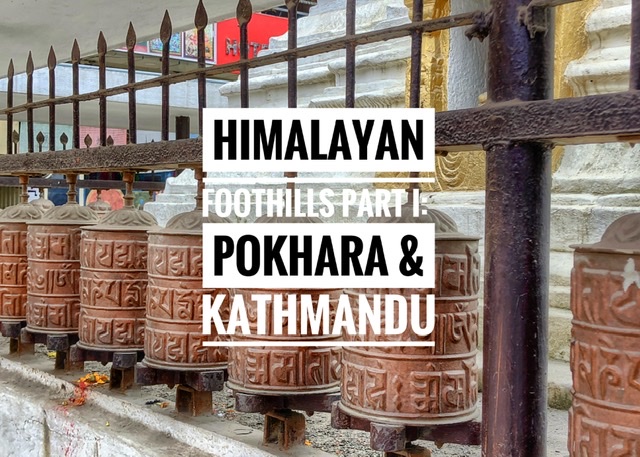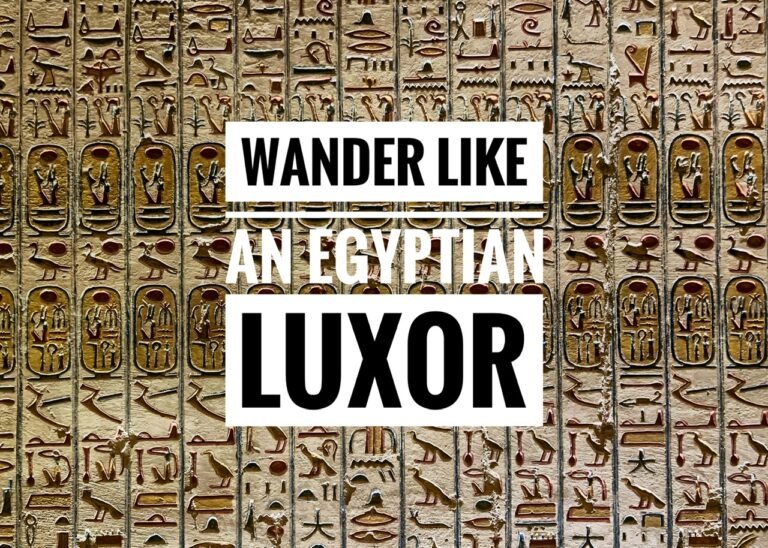
Transylvania… an evocative and mysterious land that seems to dominate the plots of so many vampire and werewolf tales. A place that seems ingrained in our imaginations to be a storybook land of fog enshrouded valleys and forgotten-by-time quaint medieval villages punctuated by dark and foreboding castles perched on rocky outcrops. But its storied cobblestoned streets, spellbinding castles, and unbelievably well preserved medieval architecture are very real and just as magnetic as you hope they would be.

Sighisoara
Stepping onto the wonderfully winding stony lanes of the (car-free!) walled old town citadel that surrounds this town is like stepping into the Easter-egg-hued pages of a Grimm’s Fairytale. Seriously, Sighisoara is a must-do if you come to Romania. Walking through this fairytale village you half-expect a brilliant fuschia butterfly to perch on your shoulder and a congregation of little dwarves to come guide you along. Alas, that didn’t happen… so we just strolled on down storybook lane, and created our own.
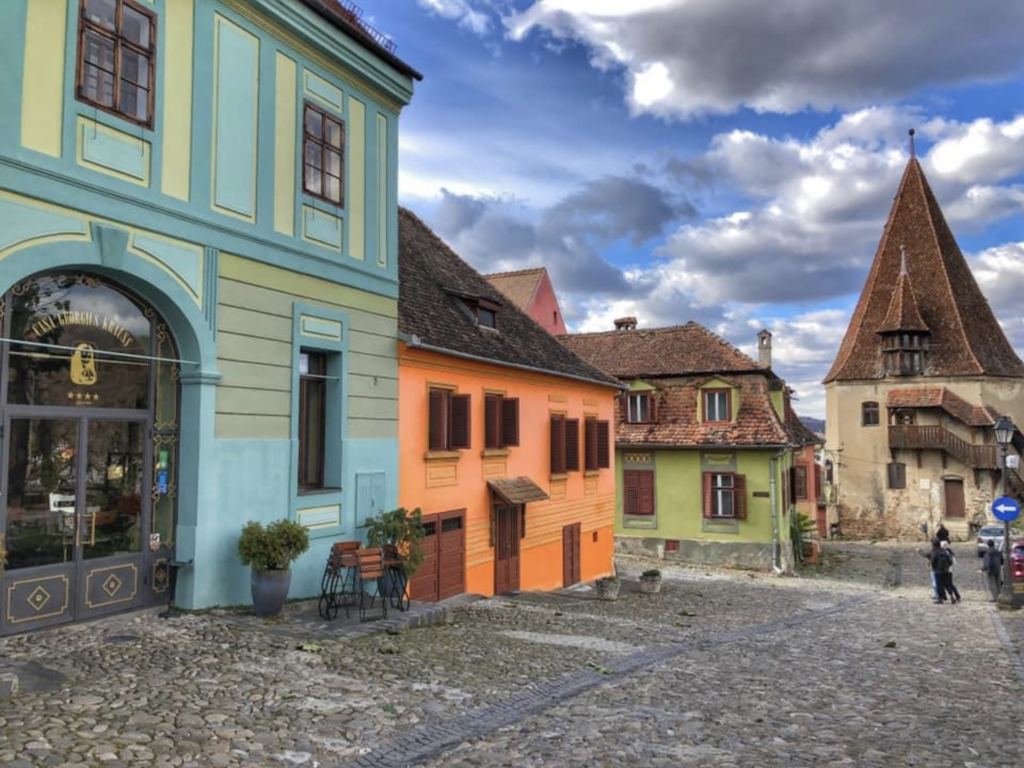
Another street scene, circumvented by protective walls and towers. The entire citadel of Sighişoara is listed as an UNESCO site.

This view was taken from the top of the striking main clock tower, Turnul cu Ceas. Notice the doves circling in the mid-left part of the picture, they caught our eye as we let out a collective, ah! And, Wow! While standing in the tower. Just a beautiful moment!

This tower dates from 1280 and is an astounding 209 feet tall topped by a main spire and four mini spires. Its multi-colored roof glitters like the scales of a serpent. Astounding how they were able to construct something that tall so many hundreds of years ago, and it still stands!
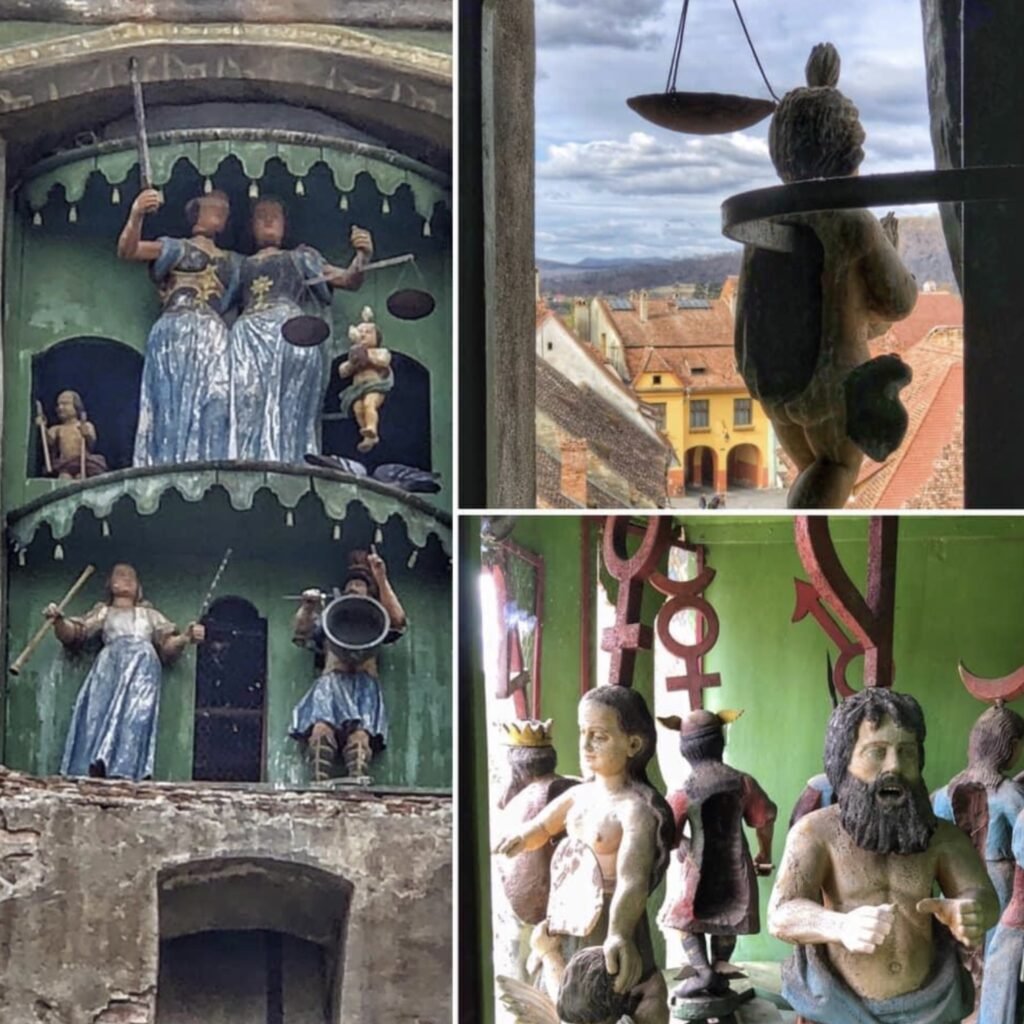
Inside the tower, you can get up close and personal with the characters that reside here. Two (slightly demonic-looking) angels move back and forth on the clock to symbolize sunrise and sunset as musicians play nearby on the hour. Interestingly, the ring of figurines represent each day of the week. Pictured here are Venus, who represents Friday and Saturn, who represents Saturday. We visited on a Thursday so Jupiter is facing out towards the main square.

Other views inside the tower, including one of Holy Trinity Church.

Clock Tower. Pictured bottom left, the building in the foreground is Casa Vlad Dracul, the actual childhood home of the notorious Vlad Tepes, aka “Dracula” born and lived here from 1431-1435. Talk about an intriguing celebrity home to wander through! We couldn’t believe it’s still standing!

It is true that Vlad Dracul was indeed a real person. He was born into nobility and reigned over Wallachia, what is current day southern Romania in the mid 1400’s. The Prince of Wallachia however had a very turbulent childhood after being kidnapped and spending 12 years of his youth held captive in a Turkish prison. This imprisonment at the hands of the Ottoman Turks later fueled his ceaseless desire to take revenge on any and all Turkish, including any Ottoman sympathizers in his own land, once he had managed to escape captivity and regain his throne years later. He was able to learn to speak fluent Turkish during his imprisonment, a skill that would later prove to be exceptionally valuable in exacting his revenge on the Ottomans.

Because of his deep seated and unwavering hatred of the Ottoman Turks, Vlad and his army was one of the few rulers in European lands at the time who was always ready and willing to take on the Ottomans. His efforts in Romania likely prevented the Ottomans from launching a full-on invasion and taking over Christian Europe. Vlad’s tactics for combating his enemies were unorthodox and vicious… to say the least.
Although he used what should be considered very ingenious battle tactics for his time, if they weren’t so fiendish, like early germ warfare, espionage, and psychological warfare he quickly gained notoriety by employing one particularly nasty and shocking method of killing his enemies. He became known as, Vlad the Impaler (Tepes), due to his preference for impaling his enemies on large wooden stakes driven into the ground. As you can see by this famous painting, Mr. Impaler enjoys a dinner while supervising the skewerings. Fair warning this is graphic… For those he loathed the most, pretty much any Ottomans, they would get the ‘Vlad special’ impaling. This involved hoisting the (still living) victim above the stake and skewering them up through their rectum and out their shoulder blades in such a way as to avoid puncturing any major organs. This process would allow the victim to remain…alive…on the stake for up to 48 HOURS! Often times Vlad Tepes would leave the corpses staked up as a warning to others for weeks or months, or until nature took its course. According to the book “Backpacking with Dracula” by Leif Peterson, “Vlad not only kept Ottomans too discombobulated to move forward, but he actually pushed them BACK toward Constantinople” by using such horrific battle tactics.

And the other Dracula, created by Bram Stoker. The one that launched vampire-fever from the beginning of its creation through more novels, movies and plays then can easily be counted. Funnily, other than his “thirst for blood,” Vlad’s part in being the inspiration for the Dracula character was actually very minimal.
For the record, Bram Stokers‘ Dracula legacy is not always welcome by Romanian citizens. According to Peterson, “Romania was so incensed by Count Dracula’s rising game infringing on their treasured culture that Dracula novel was not translated into Romanian or sold in any form in the country until after the fall of communist leadership.” But alas, they have begun embracing his tourism draw and he now awaits eager tourists when they go up the stairs to Vlad’s childhood room to give you a good “scare.”

Next we visited Teo’s Cellar, a cozy 500-year-old wine cellar in the old Citadel. Teo gave us an amazing tasting of his products including traditional plum and pear palincă, and a “fructe de pădure” liquor! We even bought a bottle. A big deal because as wine and beer people, we’ve never once bought a bottle of spirits in our relationship. It was obviously irresistible!

This is where we stayed during our week in Sighisoara (which by the way was too long without a car! We were virtually trapped here because of limited bus/train schedules.) It was the upstairs of this home, which we shared with our hostesses, a couple of pensioners who spoke zero English. They did speak French however. Mandy made the mistake of saying she spoke “un peu” Francais so was pulling out her hair trying to remember her long-forgotten high school language choice. ?
This couple was also interesting because we witnessed them using the gas line from the stove to make homemade spirits in their garage, just below us. Not exactly a fire-safe thing to do. Eek.
Medias

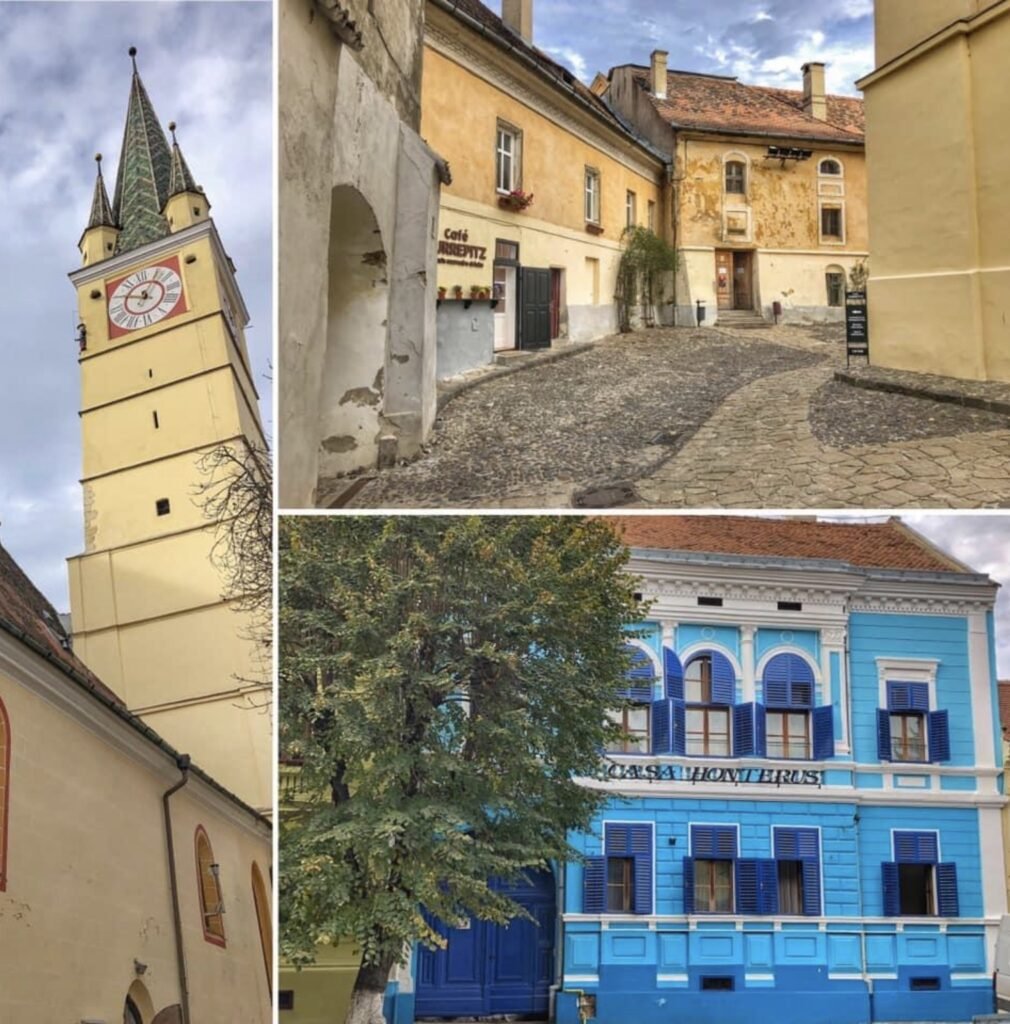
One of the day trips we did manage to take landed us haphazardly in another Saxon town of Medias (although we were actually trying to go to the UNESCO site of Biertan further afield.) Utterly unable to make our way to Biertan, we decided to make the best of it spontaneity and explore Medias instead. As one of the oldest towns in Transylvania, it was a lovely town to stroll around in and grab pizza. Romanians, by the way, make pretty stellar pizza, which is fortunate as a fallback food when they’re cuisine gets a bit…unappealing.
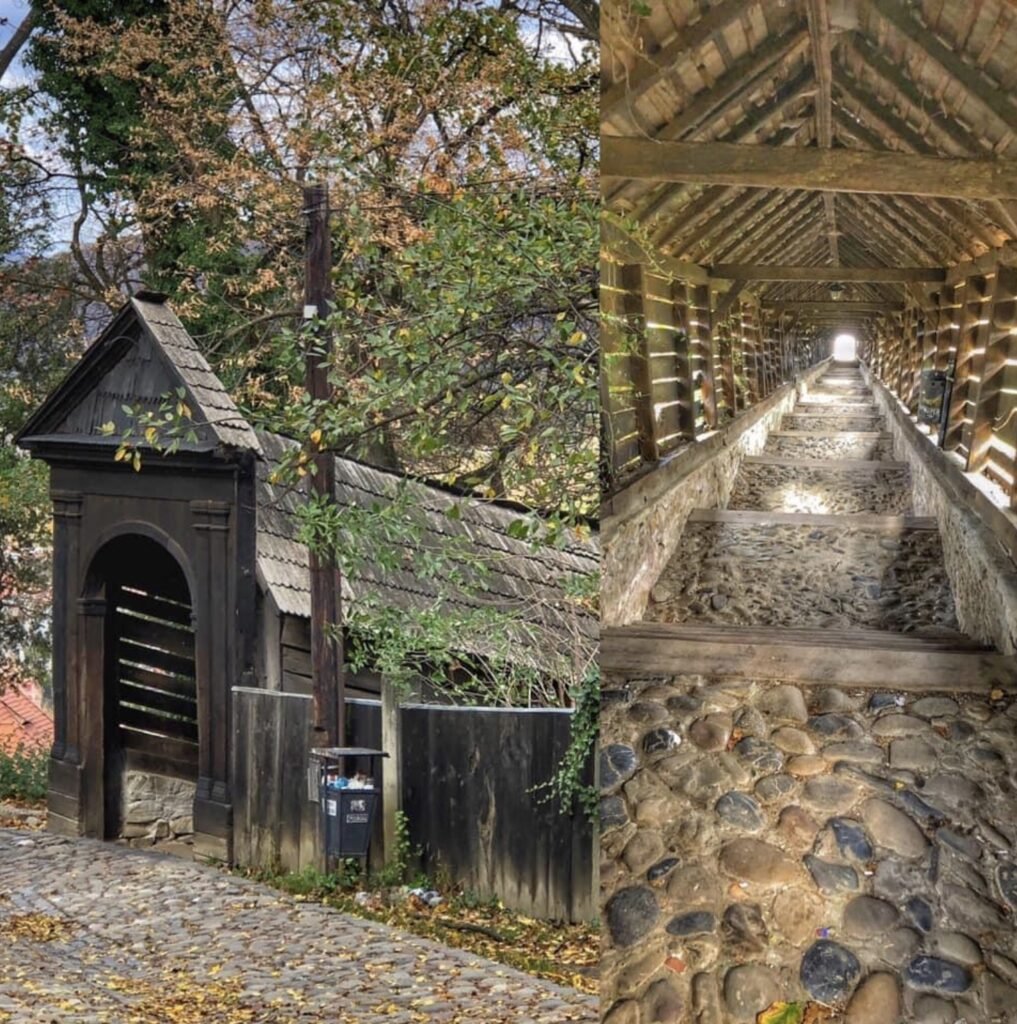
Back in Sighisoara, we meandered our way up to the Church on the Hill through the Scholar’s Stairway. We had never seen anything quite like it! This 176-step wooden covered staircase was built in 1642 and adds to the gothic mystique of the citadel. It was built to protect school children in the winter months when walking up to school. The church and cemetery at the top are also worth a visit.

Breite Oak Tree Reserve
The next day we walked from Sighisoara to the Breite Oak Tree Reserve, which was about 2km west of town and encountered lovely views like this one.

The oak tree reserve was bucolic and enchanting… with gigantic 800-year-old oaks it was easy to be awed by these beautiful trees. You can see Mandy in the bottom right for scale here.
Turda Salt Mines

After Sighisoara, we stayed one night in Turda to visit Salina Turda, one of the oldest salt mines in the world and one of the most unique places we’ve found. This mine was dug in the Middle Ages for (table) salt exploitation. It is now however solely used for tourism. Walking underground into the mine takes you 200+ feet down and into a 13 story(!) underground chamber carved out of the salt. Inside this saline wonderland you will also find lots of activities to keep you occupied like a Ferris wheel, a natural lake with rowboats, bowling, ping pong, mini golf, billiards, salt sand pit and playground, and amphitheater. All this to help you pass the time breathing in the beneficial salt laden air. Cost is 15 Lei, or about $4.

The Ferris wheel. You can see the walking path up above to get an idea on depth.

Looking down into the natural lake with rowboats.

The main entrance stairwell and salt encrusted structures within.
Sibiu

Arriving to the culturally diverse town of Sibiu, we were greeted with Saxon influence, divine walkable pedestrian streets and the main square which was a delightful reminder that the Christmas markets were right around the corner!
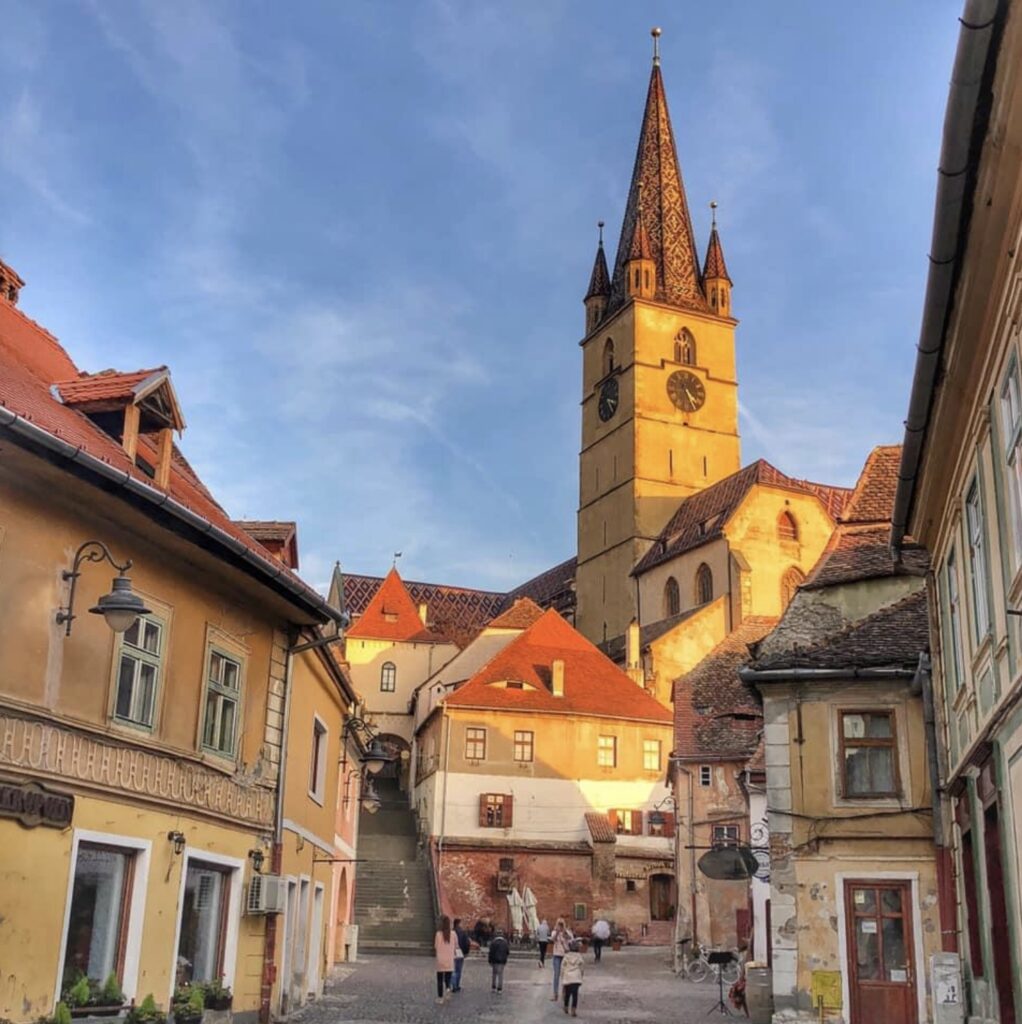
Sibiu’s gothic centerpiece, St. Mary’s Evangelical Church, towers 240 feet over Old Town, which like the other Saxon towns is ringed by a medieval fortress wall. The church was built from the mid-1300’s to 1520. The tomb of Vlad Tepes’ son is behind the organ. He was murdered in front of the church in 1510.

Taken from inside the tower of St Mary’s. The mountains were simply stunning in the distance.

Lovely passages everywhere!
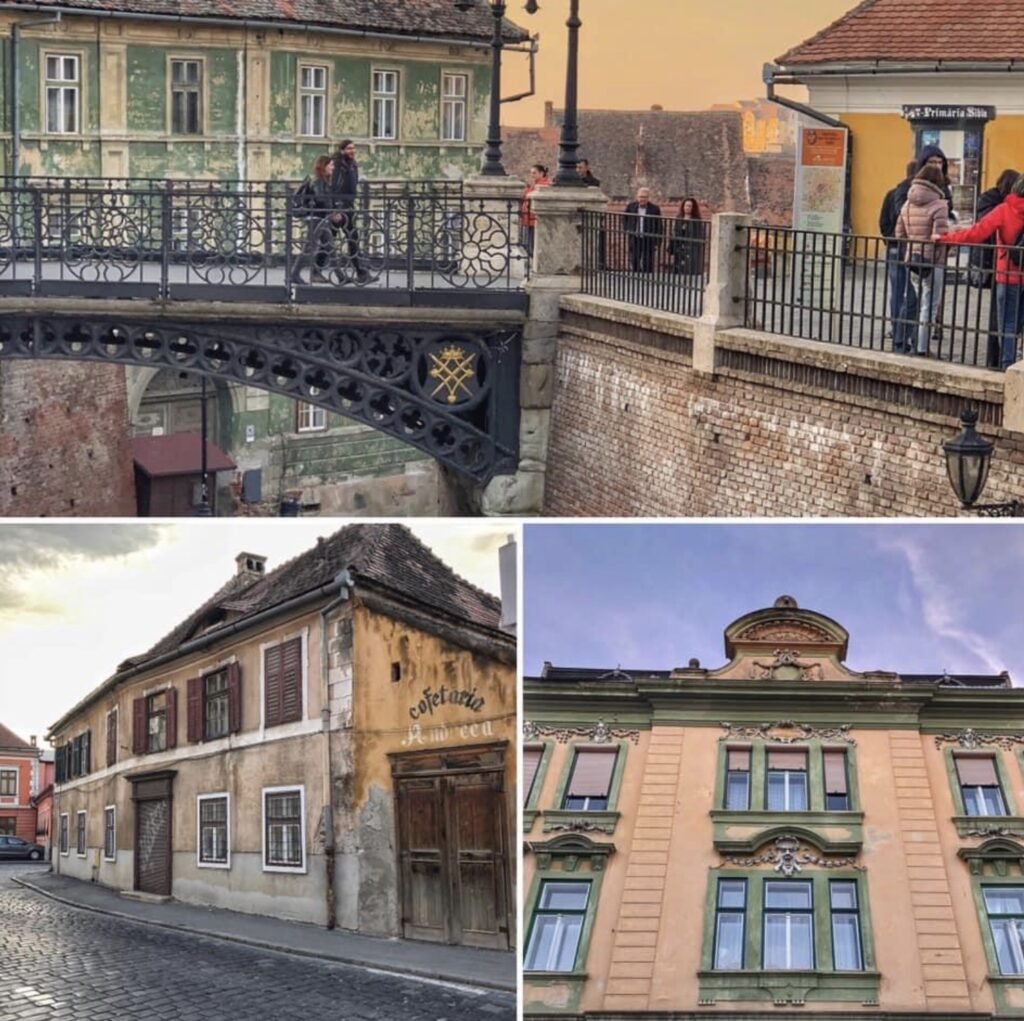
More Sibiu street scenes. At top, the Bridge of Lies built in 1859. If you tell a lie upon it, it supposedly creaks.

Street scene from Bridge of Lies

The charming, chubby “Thick Tower” is reminiscent of a medieval Smurf’s residence and more street scenes.

The city walls and the 39 adjoining towers of Sibiu are some of the most remarkably preserved. This is one particularly beautiful stretch.

Holy Trinity Cathedral
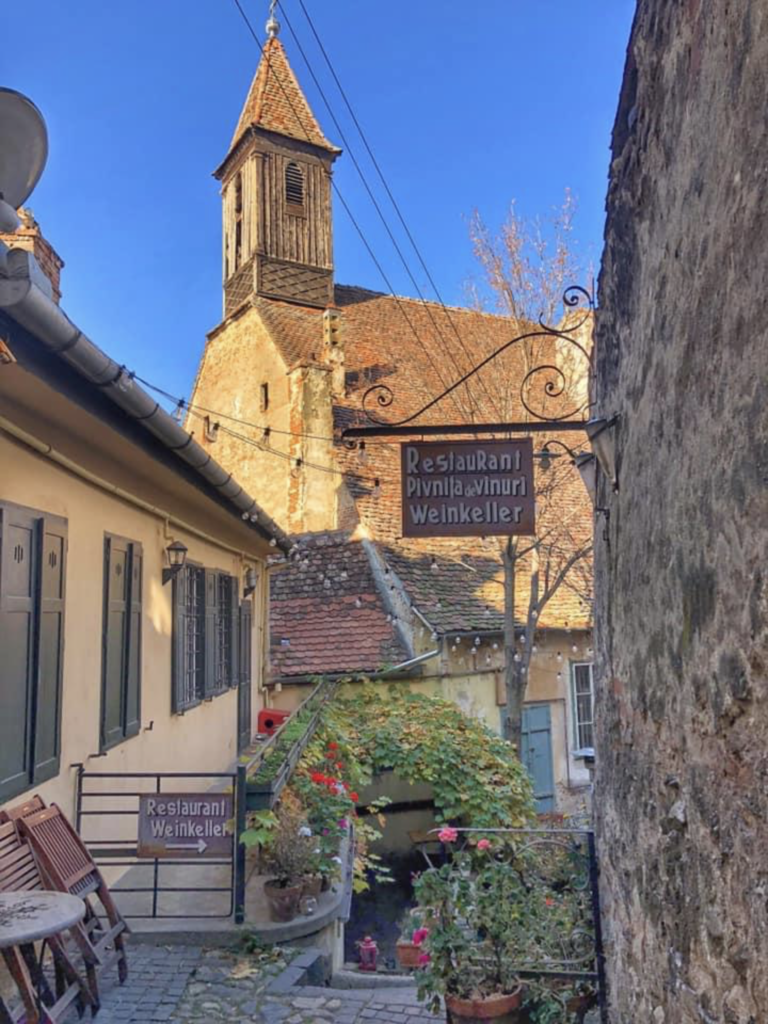
Huet Square
Corvin Castle, Hunedoara

Like in Sighisoara, taking day trips from Sibiu was ridiculously challenging without a car. Having learned from Maramures, we decided to rent a car for the day so we could gallivant to the castle we desperately wanted to see…Corvin Castle in Hunedoara. Corvin Castle is arguably Transylvania’s most captivating and eye-catching fortress. With its dramatic architecture and pointed turrets, daunting moat, and spellbinding drawbridge, it is what little boys and girls paint a picture of in their imaginations when they fantasize a castle.
This castle was built atop a 14th-Century stone fortress by Ioan Hunedoara, mostly by the hands of Turkish prisoners. It is believed to have been cursed by three prisoners when they were condemned to death after they were promised freedom after successfully digging the well. They were likely tossed in the Bear Pit, where prisoners were oft discarded once they had outlived their usefulness, as morsels for the captive bears.

The main courtyard

The bear pit, one of the few remaining fireplaces, and one of the interior walls that rose over 40 feet. It is likely this was three different levels at one point.
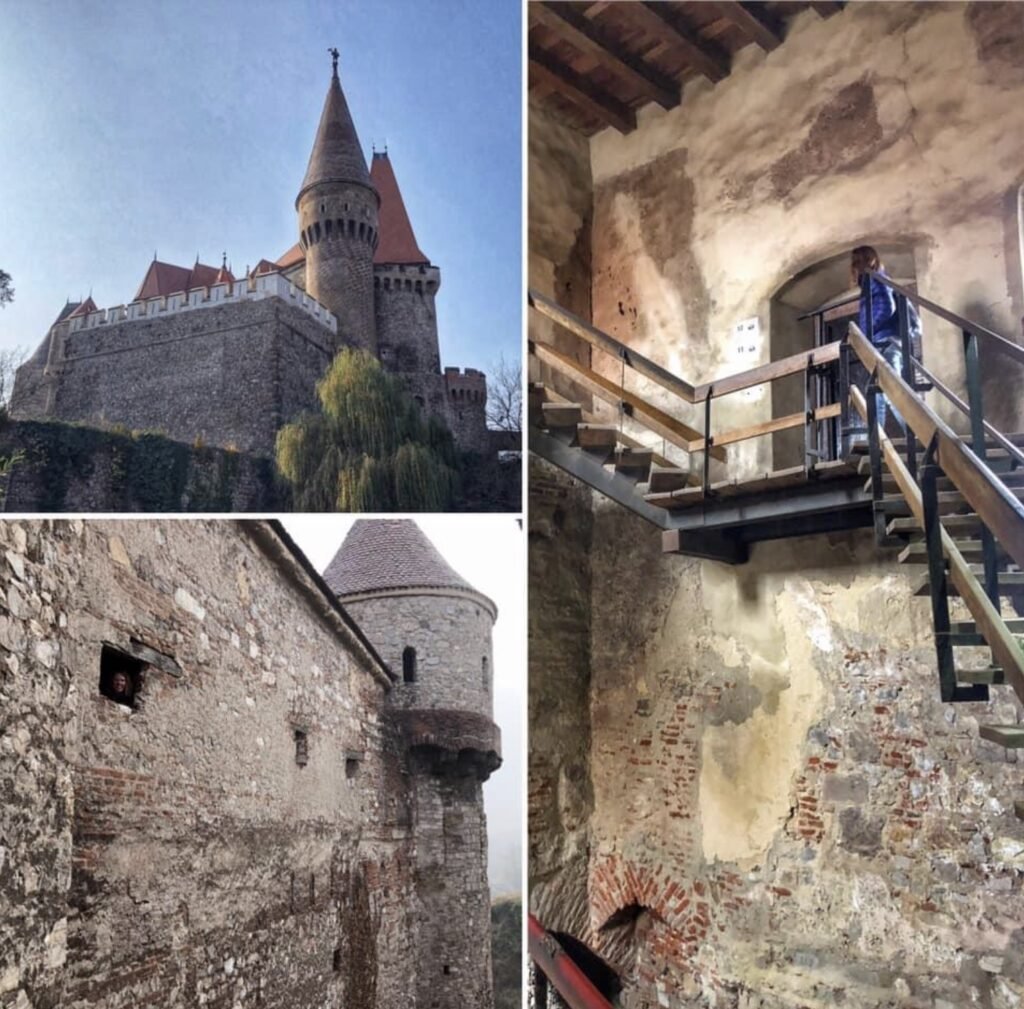
More Corvin exploration. Can you find Mandy hiding in this collage? ?

Knight’s Hall
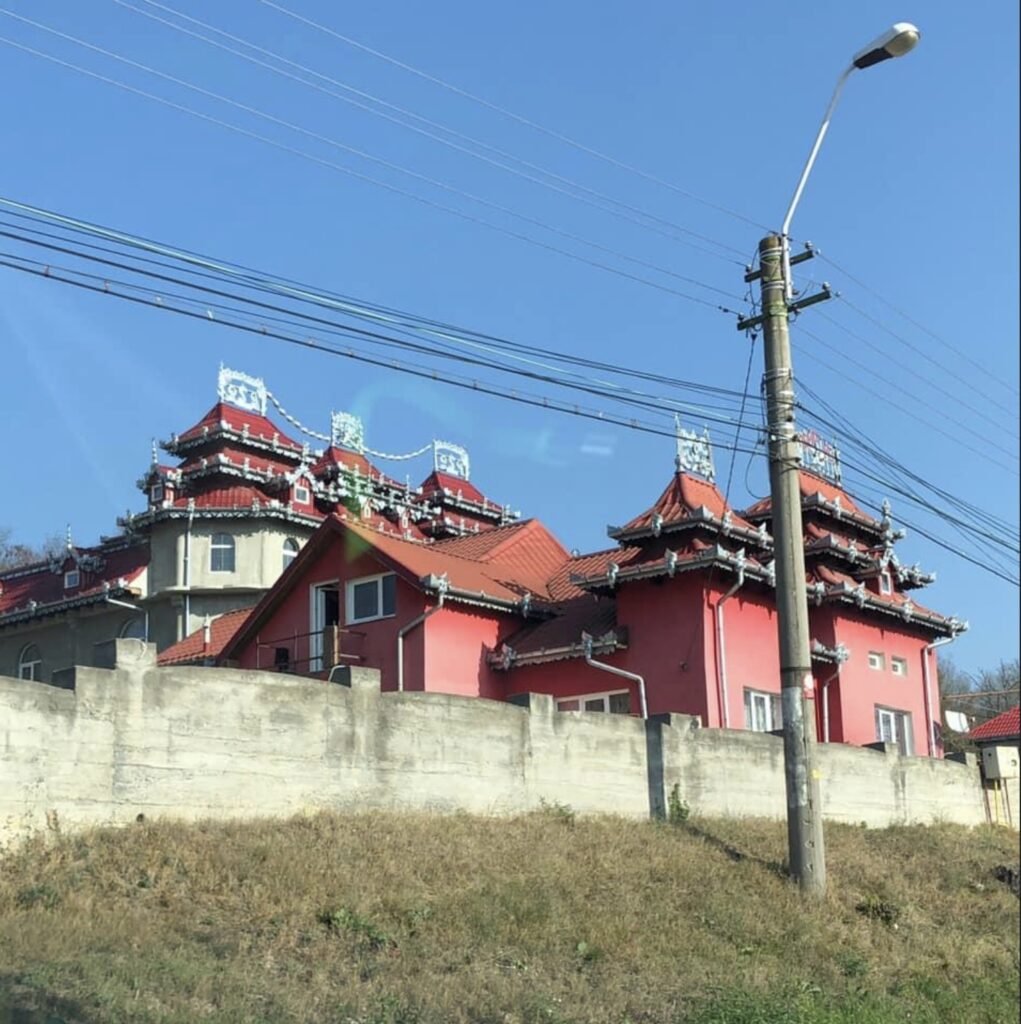
Driving by some oddly placed huge ornate houses, which looked more like palaces, lined the outskirts of Hunedoara. As more and more of these oddly out of place mansions started popping up we became quite curious about them. Multi-tiered tiled roof lines embellished with polished brass and tin sculptures and figurines the architecture of them looked more Hindi or Southeast Asian to us than Romanian.
Only online did we discover these were in fact communities of Roma people that own/occupy these mansions. Apparently they show-boat their wealth among their community members and gain standing by constructing these elaborate and flashy homes, each trying to outdo another. It’s a fascinating to dig into the peculiarities of Roma cultural traditions in Eastern Europe. Especially when you consider that the Roma first came to Romania (and other European countries) about 500 years ago from India by caravan. Just looking at these houses, architecturally so very different from western forms and still influenced from the East, Half a millennia later, it would seem that they are able to maintain a cultural niche for themselves despite being surrounded by a different cultural landscape.
Sarmizegetusa Regia Roman Ruins
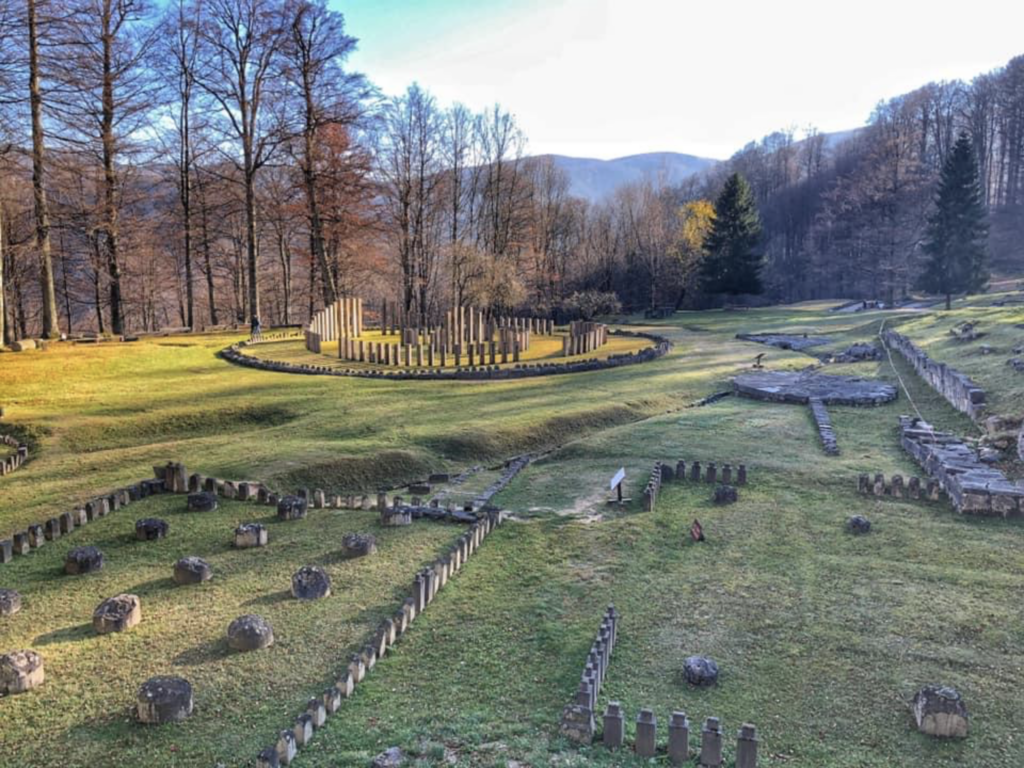
A fun stop we got to do because we actually had a car—Sarmizegetusa Regia. Occupied since before the Romans, these archeological ruins from 1200-1500 BC…are about 2 hours from Sibiu and are known as “the Stonehenge of Romania.” And we had it all to ourselves!

The remains of columns, and an ancient road, still in place.

The ancient city wall, the main stone altar and a more modern reminder to watch your step or you may have an unwanted encounter!
Romania Wrap-Up
Time Spent: 32 days
Money Spent: $1664.84 or $52.02/day
Budget Travel Meter*: $$$
The upsides of Romania
- Remarkably well preserved medieval centers and unique history
- Not too touristy
- You can experience Europe the way it used to be centuries ago, particularly in Maramures County
- Cheap and delicious wine, especially from the local winery outlets where you can fill up a liter bottle of wine for $1.50
- Abundant rural settings and wild nature, including dogs and bears
- Corvin Castle—what little kid dreams are made of
- It’s reasonably cheap, although not as cheap as other nearby countries.
- Very inexpensive and easy to rent a car and excellent roads
The downsides of Romania
- The transportation is definitely not what we expected in comparison with other Eastern European countries.
- Bran Castle—overdone, overhyped and not worth it
- The food, other then pizza, is not particularly dynamic or flavorful
- Dogs and bears
Would we go back? Yes, definitely, but wouldn’t be a top choice. We felt we got a good taste of the country in a month.
Budget Travel Meter* The Budget Meter gauges how hard it was for us to stick to our $50/day budget factored by our daily food consumption options.
- $ – Eating-out up to twice a day and ordering whatever the hell we want, with dessert!
- $$—Eating-out once a day in a restaurant of our choice
- $$$—Eating-out once a day, on cheap pizza or local street food meals, usually involving copious amounts of filling bread
- $$$$—Eating-in every meal, healthy/fresh & in-season produce options
- $$$$$—Eating powdered soup & potatoes for every meal.

